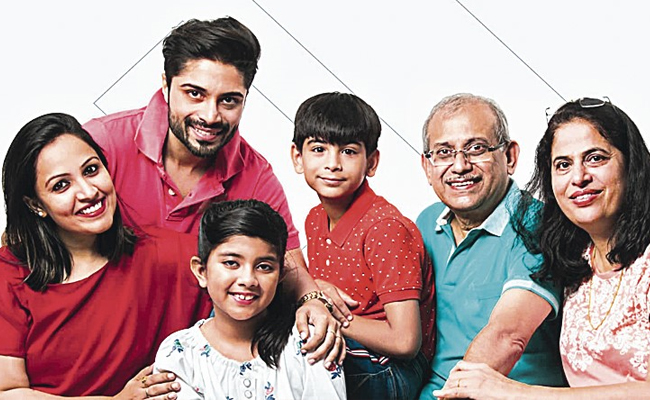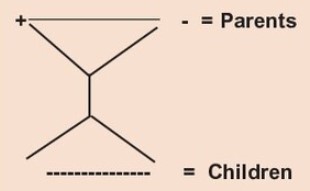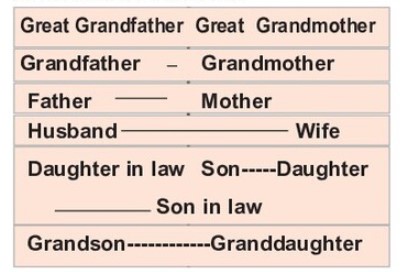Bit Banks and Material on Family Relations for Bank Exams in English

Family relations questions may be asked in the puzzle form (or) in the form of seating arrangement (or) in the symbolic form.
Generally, a roundabout complicated description is given in the form of certain small relationships and direct relationship between the persons concerned is to be found out. Hence, the candidate is definitely required to know the following:
☞ Strong knowledge of family relations
☞ Analysis of the given statements carefully and connecting them systematically.
Hence, a foolproof methodology has to be followed.
The following methods can be applied for solving the questions;
1. Personalization method
(Or)
2. Pictorial method
Personalization Method
Here, the problems can be solved by translating the given information into one’s own mother tongue and substituting unknown relationships with one’s own kith and kin. To simply put it, visualizing the information from your point of view by being a part of it.
Pictorial Method
Representing the given statement(s) in the form of a diagram/chart.
In drawing the diagram/chart, there are no hard and fast rules. You can use your own symbols to depict the information, but give no room for ambiguity. Generally we can draw a diagram similar to the ‘Traditional Family Tree’ as used in history books. To be clear about the gender, we use ‘+’ for male and ‘-’ for female and ‘?’ for unknown.
GOLDEN RULE:
The key factors for clearly answering the question on blood relations are
GENDER OF THE PERSON
GENERATION
The following notations can be drawn to indicate the relations as one has to take care of not to misrepresent the data, while drawing the diagram.
‘Horizontal lines’ are drawn to indicate marriage;
= marriage relationship
‘Broken lines’ for sibling relationship
= sibling relationship
‘Vertical lines’ indicate Parents and children,

Remember the important points given below
(1) After you have read the question, identify the persons between whom relationship is to be established.
(2) Try to correlate the given relationships.
(3) While concluding about the relationship between the two persons; be careful about the genders of the persons involved.
Point to remember
Generally, candidates get carried away by their personal biases and preconceived notions. For example, Sandeep is brother of Krishna. Krishna is brother of Chaitanya. Then, how Chaitanya is related to Sandeep?
We only know that Chaitanya is sibling of Sandeep and Krishna. But, we don’t know the gender of Chaitanya. Hence, Chaitanya can be brother or sister of Sandeep.
As said above, a roundabout description is given which should be put in direct form. Below are some of such statements:
l My mother’s only child means myself.
l My grand father’s only child (the only child of my grandfather) is my father (or) my mother.
l My grand mother’s only child (the only child of my grandmother) is my father (or) my mother.
l My father’s mother’s only child is my father
l My father’s brother’s only sibling is my father.
l My grandfather’s only son = My grandfather has only one son. But, it does’nt specify whether my grandfather has got daughters or not. Hence, my grandfather’s only son could be my father or my maternal uncle.
l Similarly, My grandfather’s only daughter = My grand father has only one daughter. But, it does not specify whether my grandfather has got sons or not. Hence, my grandfather’s only daughter could be my mother or my paternal aunt.
l Kavya’s husband’s father-in-law’s only daughter means Kavya (herself).
The following summary of some common Blood relationships will be useful to the students.
Relation |
Commonly used terms |
| Mother’s Brother | Maternal Uncle |
| Father’s brother | Paternal Uncle |
| Mother’s Sister | Maternal Aunt |
| Father’s Sister | Paternal Aunt |
| Mother’s Father | Maternal Grandfather |
| Father’s Father | Paternal Grandfather |
| Mother’s Mother | Maternal Grandmother |
| Father’s Mother | Paternal Grandmother |
| Son’s Wife | Daughter-in-law |
| Daughter’s husband | Son-in-law |
| Husband’s (or) Wife’s sister |
Sister-in-law |
| Husband’s (or) Wife’s brother |
Brother-in-law |
| Brother’s (or) sister’s son |
Nephew |
| Brother’s (or) sister’s daughter |
Niece |
| Uncle’s son (or) daughter |
Cousin |
| Aunt’s son (or) daughter |
Cousin |
| Sister’s husband | Brother-in-law |
| Brother’s wife | Sister-in-law |
| Grandson’s (or) grand daughter’s daughter |
Great grand daughter |
| Grandson’s (or) granddaughter’s son |
Great grandson |
Note: Whenever we are describing a relation on father side, prefix ‘paternal’ is used while that on the mother side, prefix ‘maternal’ is used.
In addition to the above, the following terms and statements should be noted for clearly understanding the relationship.
SIBLINGS : children of same parents (brothers and sisters)
CHILD: son or daughter (the term ‘child’ indicates son (or) daughter as it does not indicate any gender)
SPOUSE: Husband (or) Wife
The generation of a family can be understood as follows:

Following are the models in blood relations.
1. IDENTIFICATION MODEL
2. SYMBOLIC RELATION MODEL
3. INTRODUCTION MODEL
Model No. 1 and 2 are important as 4-
5 questions are expected from either of these models.
Tags
- FamilyBond
- family relations
- Competitive Exams
- Bank Exams
- bit banks and study material for bank exams
- bank exams related questions
- model questions for bank exams english
- material for bank exams english
- family relations based material for bank exams
- competitive bank exams
- english material for bank exams
- relations based material and questions
- bit banks for bank exams
- material and model questions for bank exams
- Education News
- Sakshi Education News




















